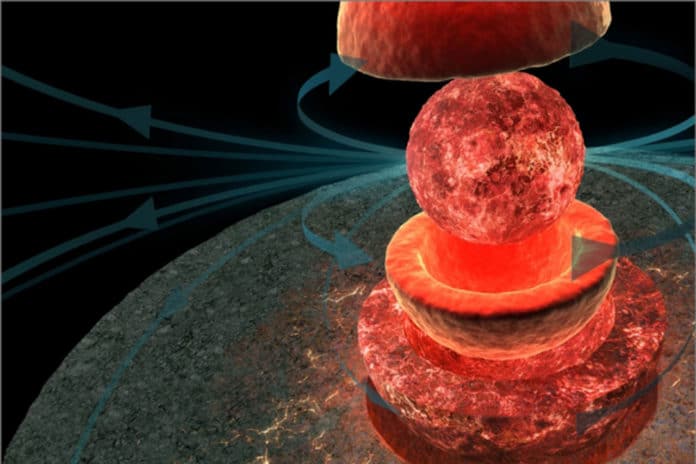Paleomagnetic measurements of Apollo samples indicate that the Moon once generated a core dynamo with surface field intensities of several tens of microtesla during the period 4.25 to 3.56 billion years. It has been unknown how long the dynamo persisted beyond this time.
The time of the dynamo’s cessation has significant implications for the mechanism of magnetic field generation as well as the thermal and mechanical evolution of the lunar interior. Recent evidence provided by the MIT scientists- suggests that lunar dynamo will end in around 1 billion years.
The new timing rules out specific hypotheses for what drove the lunar dynamo in its later stages and supports one specific component: core crystallization. As the moon’s inner iron core crystallized, the liquid core’s electrically charged liquid was buoyantly stirred, delivering the dynamo.
Benjamin Weiss, professor of earth, atmospheric, and planetary sciences at MIT, said, “The magnetic field is this nebulous thing that pervades space, like an invisible force field. We’ve shown that the dynamo that produced the moon’s magnetic field died somewhere between 1.5 and 1 billion years ago, and seems to have been powered in an Earth-like way.”
“There are several ideas for what mechanisms powered the lunar dynamo, and the question is, how do you figure out which one did it? It turns out all these power sources have different lifetimes. So if you could figure out when the dynamo turned off, then you could distinguish between the mechanisms that have been proposed for the lunar dynamo. That was the purpose of this new paper.”
Scientists identified two samples of lunar stone, gathered by astronauts during the Apollo missions, that seem to have endured a massive impact around 1 billion years prior and subsequently were dissolved and welded back together so that their ancient record was all but erased.
The group returned the samples to the lab. It first analyzed the orientation of each rock’s electrons, which Weiss describes as “little compasses” that either align toward a current attractive field or show up in irregular directions without one. For the two examples, the team observed the latter: random configurations of electrons, proposing that the rocks framed in an extremely weak to zero magnetic fields, of close to 0.1 microteslas.
Using the Radiometric dating technique, scientists determined the age of samples. Next, the samples were checked if they were indeed good magnetic recorders.
Scientists wanted to check if the rocks could record even a weak magnetic field on the moon if it existed. To do so, they placed both samples in an oven and blasted them with high temperatures to effectively erase their magnetic record. The rocks were then exposed to an artificially generated magnetic field in the laboratory as they cooled.
Scientists found that the rocks were indeed reliable magnetic recorders and that the field strength they initially measured, of 0.1 microteslas, accurately represented the maximum possible value of the moon’s fragile magnetic field 1 billion years ago.
The new findings line up with the predicted lifetime of core crystallization, a proposed mechanism for the lunar dynamo that could have generated a weak and long-lived magnetic field in the later part of the moon’s history.
Weiss said, “Before core crystallization, a mechanism known as precession may have powered a much stronger though shorter-lived dynamo. Precession is a phenomenon by which the solid outer shell of a body such as a moon, close to a much larger body such as the Earth, wobbles in response to the Earth’s gravity. This wobbling stirs up the fluid in the core, the way swishing a cup of coffee stirs up the liquid inside.”
The group is looking next to measure the direction of the moon’s ancient magnetic field in hopes of gleaning more information about the moon’s evolution.
The findings appear today in the journal Science Advances.
